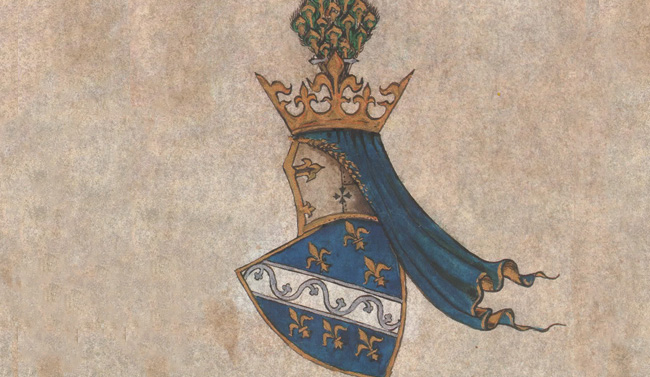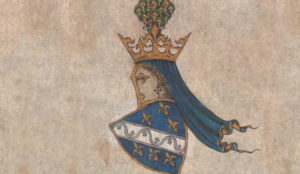
(Ljubiša Malenica translate)
With dynasty of Nemanjići, Kotromanići are one of two largest and best known Serbian medieval ruling families. Accordingly, coat of arms of the house Kotromanići is, in Serbian medieval heraldic, second in importance only to coat of arms of house Nemanjići. As their coat of arms, Kotromanići used shield with lilies. Position of the flowers on the family crest was not always the same, but it was certainly the main symbol of the house.
Lily symbolism is strongly connected with Christianity given that lily, or fleur-de-lis, symbolizes the Virgin Mary. It appeared often on crests of rulers or noble houses all across medieval Christian Europe. On the territories of the Serbian medieval states lilies were often depicted on churches, frescoes, coins and grave ornaments which additionally validate the religious symbolism of this flower.
One of the oldest depictions of lily in Serbs can be found on gravestones near monastery Prevlaka, which date back to IX-X centuries. This is understandable once we realize that Christianity spread amongst Serbs first from shores of Adriatic and then moved towards inner regions of the Balkans. With spread of Christianity, motif of lily spread as well.
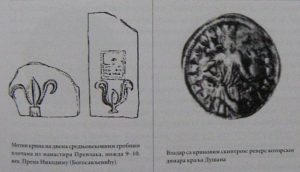
We know for sure that Byzantium had significant impact on Serbian culture which attributed to adoption of originally byzantine religious and state symbols by the Serbs, such as two-headed eagle, ocilla and eventually, the lily.
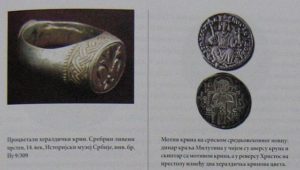
For instance, lily can be found on coins forged during reign of king Milutin, while the crown of lilies from the coffin with remains of St. Simeon is dated to somewhere between 1350-1370.
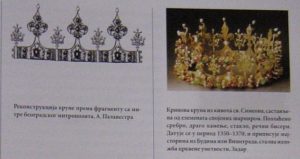
Crest of the noble house of Buća(Bućić) from Kotor which provided protovestiarios (ministers of finance) to tsar Dušan, tsar Uroš, knyaginya Milica, despot Stefan and king Tvrtko, also had lily in its design as well as colors yellow and blue which are most often represented in the reconstructions of the Kotromanići coat of arms.

It should be noted that exact colors used by the house of Kotromanići are not known, so beside the yellow and blue version, there is also the one with red shield, white diagonal line and golden lilies. Rulers and nobles of medieval Bosnia adopted the symbol of the lily and two-headed eagle from Rascia, Zeta and Zachlumia which indicates a clear connection with dynasty of Nemanjići. Before house of Kotromanići became ruling dynasty of the Serbian kingdom, their coat of arms was devoid of lilies, easily observed on the seal of ban Stefan II Kotromanić where the family crest has only a plain shield and diagonal line:
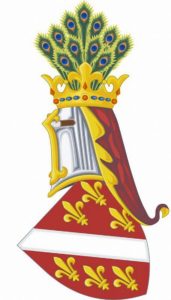
There are no lilies on the seal of ban Tvrtko Kotromanić either, but after his coronation as a Serbian king in the monastery of Mileševa in 1377, his new royal seal has the original Kotromanići house crest, expanded with lilies, while the other side of the seal contains the coat of arms of Nemanjići dynasty, two-headed eagle:
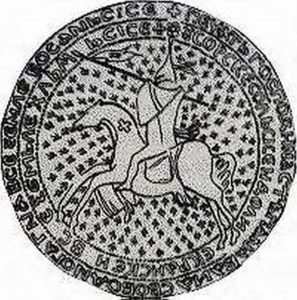
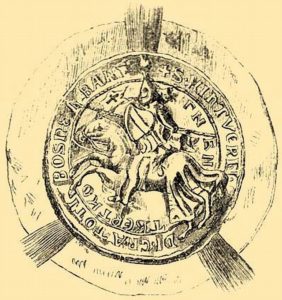
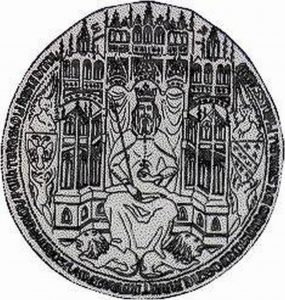
By doing so, Tvrtko was probably trying to impress upon his contemporaries that he is a legitimate hair to the legacy of Nemanjići and their state, while adding to it his own, modified, crest and traditions of the Bosnia as a state. With his act, Tvrtko emphasized the unity of two Serbian states, Rascia and Bosnia, regardless of the fact that in agreement with Lazar and other Serbian nobles he relinquished to their care, as area lords, the majority of Serbian lands east of Drina.
This unity will be best shown during the battle of Kosovo, when Tvrtko, deeming his kingdom was under attack, sent detachment of soldiers under command of Vlatko Vuković Kosača as a support to the Serbian forces.
Unlike the stylistic depiction found on the seal of king Tvrtko, gold coins forged during his reign show the crest of Kotromanići with shield diagonally splint, added lilies and royal crown.
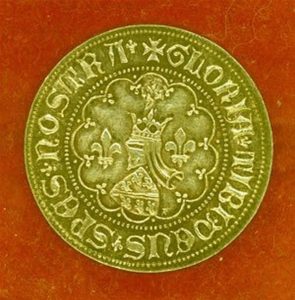
During the reign of the Tvrtkos’ heir, king Stefan Dabiša Kotromanić, the royal seal didn’t undergo any changes. It will also hold the crest of Nemanjići – the two-headed eagle and the crest of Kotromanići – lily adorned shield:
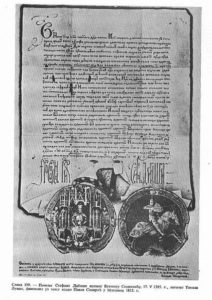
King Stefan Ostoja Kotromanić, during the first half of his rule will keep the same coat of arms, and two-headed eagle besides lilies on his seal.
Tvrtko II Kotromanić, during his first reign, removes the lilies from the crest. After deposing Tvrtko II, Stefan Ostoja changes the coat of arms once again and on the shield surface places the crown of lilies as the only motif:
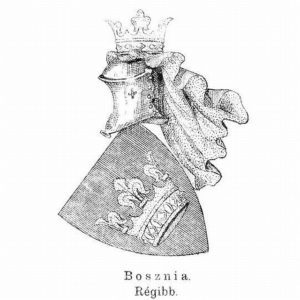
After Tvrtko II seizes throne once again, he will add first letter of his own name to the crest used by Ostoja thus transforming it into this:
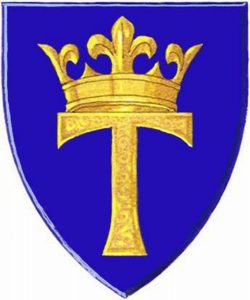
After Tvrko II, throne will go to the son of Stefan Ostoja, Stefan Tomaš Kotromanić who will introduce further modifications to the family crest by adding his initials to it:
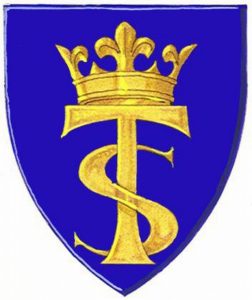
Last king from the noble house of Kotromanići, Stefan Tomašević Kotromanić will adopt the crest used by Stefan Ostoja, with the crown of lilies on the shield. Venetian painter Jacopo Bellini, in his work titled “Christ with a benefactor” depicted Stefan Tomašević in red vestment decorated with golden lilies:
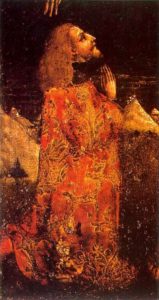
Grave of Katarina Vukčić Kosača, wife of Stefan Tomaš Kotromanić, located in Rome, is decorated with the crest of her house containing, among other symbols, two crowns of lilies:
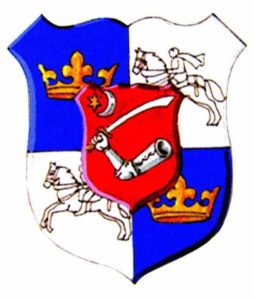
When we carefully take everything said into account, we can notice that Kotromanići adopted state traditions and symbols of Nemanjići and displayed them openly. Interesting fact is that crest of Bosnian bans had no motif of lilies until Tvrko I proclaimed himself a king after which they appear of the Kotromanići coat of arms. Given that Tvrko was crowned as a king in Mileševa monastery according to Orthodox tradition, we have a clear indication from whom Kotromanići adopted this symbol.
Given that lily symbolizes royal authority granted by God, under protection of Virgin Mary, the additional reason for adoption of this symbol becomes clear. During medieval period, amongst Serbs, the cult of the Virgin Mary was the most respected and was spread by Saint Sava after his return from the Holy Mount Athos.
Even members of the “Bosnian church”, still considered as heretics in historiography, venerated the Virgin Mary, probably even more so under influence of Zachlumia episcopacy after Zachlumia became part of the Kotromanić state.
From Byzantium, through Rascia, Zeta and Zachlumia, the symbol of lily spread to Bosnia to such extent that many medieval stećci, which can still be seen in Bosnia and Herzegovina, are decorated with stylized lilies.
Boris Radaković
Донирајте или се рекламирајте на „Срби у Босни и Херцеговини кроз епохе и судбине“ једином сајту на свијету који описује живот нашег народа на просторима БиХ од насељавања Срба у 7. вијеку до одбрамбено-отаџбинског рата а кроз призме политичке, културне и духовне историје.

